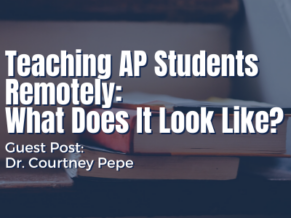A guest post by Dr. Courtney Pepe
Our current educational system is now more dynamic and complex due to Covid-19. When reflecting upon the impact of Remote Learning and teacher practice, I often think of Rogers’ Law of Diffusion of Innovation, and the Three Car Train Concept of Ray Nashar. The three car train concept places educators into different train carriages based on their willingness to adopt an innovative mindset as it pertains to technology. There is a first car for those who embrace innovative technology, a second car for those who may need more support, and a third car for those who might be more reluctant. Does the current Covid-19 crisis make middle car teachers more willing to embrace technology innovation? Are teachers who might be in the last car transitioning to the middle car out of necessity? As school systems around the world move toward a remote learning model, consideration of the needs of both teachers and students is imperative. Additionally, remote learning is not a one size fits all model. Academic resources and strategies for different content areas and specialized student populations will need to be developed and implemented. The focus of today’s article is remote learning for high school Advanced Placement students. How is assessment, instruction, and technology integration changing for our top performing high school students in light of Covid-19?
AP Instruction for the YouTube Generation
Collegeboard is leveraging various digital platforms like YouTube, Twitter, and AP Classroom to keep students engaged in relevant material from a distance. On March 20th, Collegeboard announced its provision of free remote learning resources. They have AP Online Classes and Review Classes on their YouTube Channel, and the current content features 32 different classes. The channel features daily videos of a variety of AP clusters such as: the Arts, English, History and Social Science, Math and Computer Science, Science, World Languages and Cultures. Students can view YouTube content reviewing the first 75% of the course as well as exposing themselves to the supplementary lessons covering topics in the final 25% of the course. The live stream of learning is divided into 10 different 45 minutes periods starting at 9 a.m. and ending at 6:45 p.m. On any given day students can participate in these mobile friendly classes covering AP topics such as: Tonicization through Secondary Dominant Chords, Voting Rights and Models of Voting Behavior, and Introduction to Acids and Bases. Also, Twitter is sharing these Remote Learning Resources via their AP For Students hashtag. Hourly Tweets are shared throughout the day so high school students can visual the different free, live, and on-demand AP Classes at their fingertips.
Remote Learning AP Culture of Assessment
Advanced placement students were surveyed and 91% of them responded that they wanted the opportunity to take their exams. On March 20th, Collegeboard made some initial announcements about the relationship between Remote Instruction and AP Assessment in their AP Central Platform. In 2020, AP Students will take a 45 minute version of the exam at home. The exam will be administered online and will consist of free response questions. The current committee of educational stakeholders is developing exam questions that cover curriculum content from September through the beginning of March. AP Courses typically consist of a number of Units ranging from 6-10. To ensure assessment fidelity, exams are being created that will include content from the first 4 to 7 units of the course. Portfolio based AP assessments for classes such as AP Capstone, AP Computer Science Principles, and AP Art & Design will be extended until the end of May. More information about course specific exam question types in the digital test became available on Friday, April 3rd. Digital assessment is a powerful tool to ensure that high school students still have access to their college credit pipeline during this emergency.
Remote Learning and AP Technology Integration
What is the impact that these recent assessment changes and technology integration have as they relate to AP? Plagiarism detection software will be used to secure the online exams. Also, other online AP instructional technology programs are making changes to support the shift away from the multiple choice questions and the emphasis upon free questions. AlbertiO is opening their AP preparation site for free to high schools impacted by Covid-19. Additionally, they are working on a free response question integration with Google Classroom to support remote learning. This will assist teachers as they adjust to the online assessment changes. A final important development is that the AP online exams will be device agnostic: students can take these exams on a computer, tablet, or a smartphone. Additionally, students can take screenshots of handwritten responses. This supports equity and access.
Dr. Steven Locascio, the Director of Educational Leadership at Kean University, states the following about AP Students and Remote Learning: “AP Students have the ability to work well in the realm of AP and remote learning, as they are independent thinkers who know how to engage the teachers to get what they need.” Engaging students in learning is the quintessential concept that will be the steady hand necessary to lead our educational system through this crisis. The relationship between student engagement and the digital tools outlined in this piece will foster deep and meaningful remote learning experiences for our future doctors, computer programmers, mathematicians, musicians, and artists.

